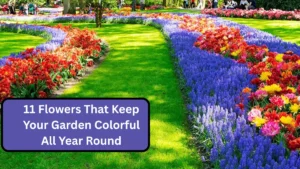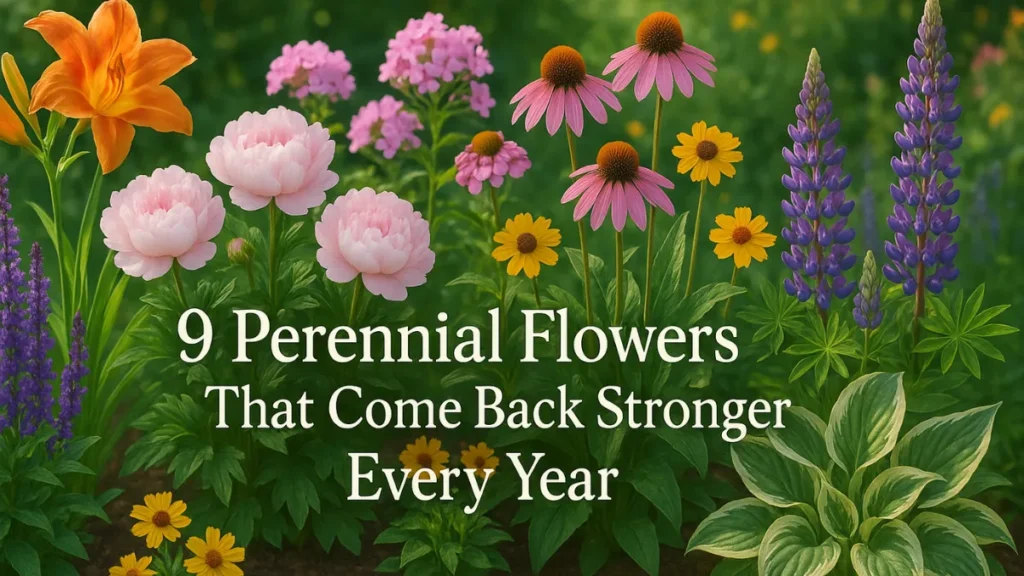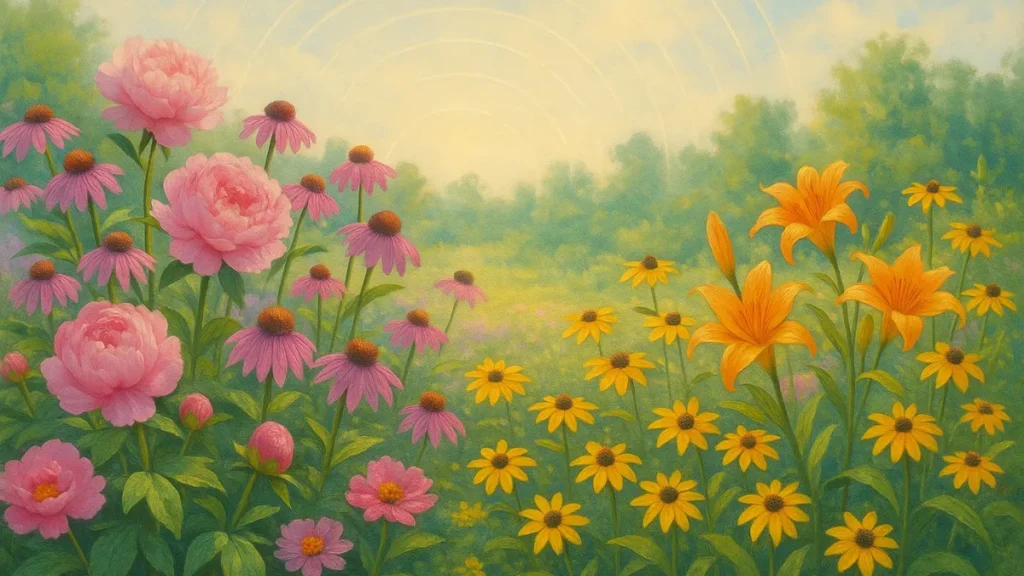A colorful garden brings life to any outdoor space, and having flowers that bloom year-round is the perfect way to achieve vibrant beauty throughout every season. From the delicate petals of pansies to the fragrant lavender, these flowers not only brighten up your garden but also attract pollinators, adding both aesthetic and ecological value.
Whether you’re looking for plants that thrive in the sun or those that flourish in shaded areas, there’s a flower for every corner of your garden. In this blog, we’ll explore 11 beautiful flowers that ensure your garden remains a striking spectacle throughout the year.
By choosing the right mix, you can enjoy continuous color, fragrance, and charm from spring through fall and even into winter. Let’s dive into these perennial favorites that will keep your garden flourishing no matter the season!
1. Pansies
Pansies are an excellent choice for adding color to your garden throughout the year. These flowers thrive in both spring and fall, making them a versatile addition. Pansies come in a wide range of colors, from vibrant yellows to rich purples, and even bi-color varieties, ensuring they stand out in any garden.
Their heart-shaped petals and delicate nature make them ideal for adding texture and vibrancy to garden beds, borders, or containers. Pansies prefer cooler temperatures and can withstand light frost, allowing them to bloom during those transitional seasons when many other flowers may not.
Regular deadheading, or removing spent blooms, helps encourage new growth and extends their flowering period. Pansies are relatively low maintenance and can be easily grown in both sunny and partially shaded spots, making them perfect for gardens with varying light conditions.
2. Snapdragons
Snapdragons are known for their unique, dragon-shaped blooms that come in various colors, including pink, red, orange, yellow, and white. These flowers can bloom in early spring and continue throughout the summer, depending on the climate.
They thrive in well-drained soil and full sunlight, but they can also tolerate partial shade. Their tall, upright growth makes them great for adding height and structure to your garden, while their colorful flowers bring a touch of playfulness. Snapdragons are ideal for both formal and informal garden settings, as they grow well in flower beds, borders, and containers.
Deadheading spent blooms encourages new flowers to appear, and they benefit from regular watering during dry spells. Snapdragons are resilient and can often bounce back after a heavy rainfall, making them a reliable choice for year-round garden color.
3. Petunias
Petunias are one of the most popular flowers for creating vibrant displays of color in gardens year-round. They come in an array of colors, including pink, purple, white, red, and blue, often with striking patterns like stripes or ruffles. Petunias thrive in full sun and well-drained soil, and they are particularly well-suited for hanging baskets, window boxes, and containers.
Their sprawling growth habit and trailing nature make them perfect for adding color to hanging baskets or cascading down from garden walls. Petunias bloom profusely throughout the growing season, from spring to fall, and with proper care, they can be encouraged to keep flowering continuously.
Regular watering and deadheading spent flowers will ensure that your petunias stay healthy and vibrant. They also have a pleasant fragrance, adding a sensory element to your garden.
4. Geraniums
Geraniums are a favorite for gardeners looking to add long-lasting color to their landscapes. These flowers bloom in an array of colors, such as red, pink, white, and purple, and their flowers can last well into the fall, depending on the variety.
Geraniums are particularly hardy and can thrive in both container gardens and in-ground beds. They prefer full sun and well-drained soil, though they can tolerate partial shade. Geraniums are low-maintenance plants that require regular watering and occasional feeding with a balanced fertilizer to keep them flourishing.
Their round, bushy growth habit and colorful flowers make them ideal for filling gaps in garden beds or for adding a pop of color to containers. Geraniums also attract pollinators, such as bees and butterflies, making them a beneficial addition to any garden.
5. Marigolds
Marigolds are an enduring choice for gardeners who want to add consistent color throughout the growing season. These vibrant flowers bloom in shades of orange, yellow, and red, offering a cheerful and sunny display in any garden.
Marigolds are highly adaptable and can grow in a variety of soil types, but they thrive in well-drained, slightly acidic soil with plenty of sunlight. They are known for their ability to deter pests, making them a natural choice for companion planting in vegetable gardens.
Marigolds are easy to care for, requiring minimal attention. Regular deadheading encourages continuous blooming, and they are relatively drought-tolerant, though they will benefit from consistent watering during particularly dry periods. Their bright flowers can be used to line pathways, borders, or containers, and their resilience makes them a reliable addition to gardens year-round.
6. Lavender
Lavender is an aromatic and visually stunning plant that brings both beauty and fragrance to the garden year-round. Known for its purple or blue-purple flower spikes, lavender blooms in late spring through summer, and the foliage remains attractive even when the plant is not in bloom.
This hardy perennial thrives in well-drained soil and full sunlight, and it is particularly well-suited for hot, dry climates. Lavender is a versatile plant that can be used in various garden settings, from formal hedges to informal herb gardens. It requires minimal care once established, making it a low-maintenance option for gardeners.
Lavender also attracts pollinators, such as bees and butterflies, which makes it a beneficial plant for a sustainable garden. Pruning the plant after blooming helps maintain its shape and encourages fresh growth, ensuring that it continues to add color and fragrance to the garden year after year.
7. Begonias
Begonias are perfect for adding color to shaded areas of your garden. With their colorful, asymmetrical flowers that come in hues of red, pink, orange, and white, begonias are ideal for creating a splash of color in lower-light areas.
These flowers thrive in partial to full shade and moist, well-drained soil, making them perfect for under trees, along shaded garden paths, or in containers placed in low-light spots. Begonias are known for their vibrant, waxy flowers and foliage, with some varieties even displaying attractive patterns on their leaves.
They are also relatively pest-resistant, making them a hassle-free addition to any garden. Begonias bloom continuously from spring to fall, with regular watering and occasional feeding helping to keep them healthy and colorful throughout the season. They are often used in hanging baskets, window boxes, and as border plants.
8. Daffodils
Daffodils are one of the earliest flowers to bloom in the spring, bringing a welcome burst of color to gardens after the long winter months. These cheerful flowers, typically yellow, white, or orange, stand tall on slender stems, creating a striking contrast against the green of early spring foliage.
Daffodils thrive in well-drained soil and full to partial sunlight, making them easy to grow in a variety of garden settings. They are also highly resistant to pests and diseases, making them a reliable and low-maintenance choice.
Once planted, daffodils can bloom year after year without much care, making them an investment for long-term garden color. After flowering, their leaves continue to provide interest in the garden, gradually fading as the weather warms. Daffodils are perfect for naturalizing in lawns, adding color to borders, or as accents in flower beds.
9. Columbine
Columbine is a perennial flower that adds a touch of elegance and variety to the garden with its unique, spurred flowers. These blooms come in a variety of colors, including red, blue, purple, yellow, and white, often in combinations that create a striking visual effect.
Columbine thrives in well-drained, moist soil and partial to full shade, making it an excellent choice for woodland gardens or shaded areas of the garden. These flowers typically bloom in late spring to early summer, attracting pollinators such as hummingbirds and bees.
Columbine is easy to care for, requiring minimal attention once established, though regular watering during dry periods will encourage continuous blooming. The plant’s delicate, bell-shaped flowers and fern-like foliage provide year-round interest in the garden, even after the blooms fade.
10. Impatiens
Impatiens are among the best flowering plants for shady gardens, offering a wide range of colors, from pinks and reds to purples and whites. These plants thrive in moist, well-drained soil and are perfect for areas with little direct sunlight.
They bloom from spring through fall, providing a steady supply of colorful flowers throughout the growing season. Impatiens are commonly used in containers, hanging baskets, and as groundcover in shaded garden beds.
Their compact size makes them ideal for filling gaps in the landscape, and their soft, vibrant blooms brighten up any corner of the garden. Regular watering and occasional fertilization help keep impatiens blooming profusely. These plants are also relatively low-maintenance, with pests and diseases generally posing minimal threats when grown in the right conditions.
11. Chrysanthemums
Chrysanthemums, often called mums, are a staple in fall gardens, providing brilliant color when many other plants have started to fade. These hardy perennials come in various shapes, sizes, and colors, including red, yellow, orange, purple, and white.
Mums thrive in well-drained soil and full sunlight, though they can tolerate light shade as well. They bloom in late summer to fall, making them perfect for extending the growing season and adding a final burst of color before winter.
Chrysanthemums are relatively easy to grow and maintain, requiring regular watering and occasional feeding to keep them looking their best. Pruning spent flowers and cutting back the plants after flowering ensures that mums return the following season. Their vibrant flowers attract pollinators, and they also make excellent cut flowers, making them a great choice for both gardens and floral arrangements.
Bottom Line
Keeping your garden colorful all year round is easier than it seems with the right selection of flowers. By incorporating a variety of sun-loving and shade-tolerant plants, you can ensure vibrant blooms throughout the year.
Flowers like pansies, snapdragons, and lavender will keep your garden thriving even during cooler months, while others like marigolds and begonias will shine in the warmer seasons. With proper care and a little planning, your garden can be a year-round haven of color and beauty, attracting pollinators and enhancing your outdoor space.
FAQs
Which flowers bloom year-round?
Pansies, marigolds, and begonias are known for their ability to bloom continuously throughout the year, especially in mild climates.
How do I maintain flowers for year-round color?
Regular watering, deadheading, and occasional fertilizing will help ensure your flowers keep blooming. Choose a variety of plants that thrive in different seasons.
Can flowers bloom in the winter?
Yes, some flowers like pansies and lavender can bloom through winter, depending on the climate.
What flowers are best for shaded gardens?
Impatiens, begonias, and columbine are excellent choices for shaded areas, providing color and vibrancy in low-light conditions.



